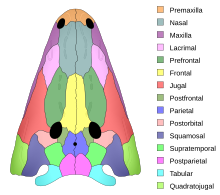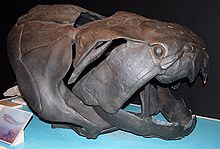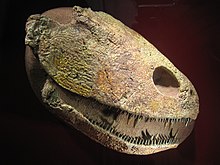Skull roof

The skull roof or the roofing bones of the
In
Origin

Early armoured fish (such as jawless
Cartilaginous fish, such as sharks, have a skeleton which is entirely formed from cartilage. They lack a continuous dermal armour and thus have no proper skull roof.
Bony fishes

In early sarcopterygians ("lobe-finned fish"), the skull roof was composed of numerous bony plates, particularly around the nostrils and behind each eye. The skull proper was joined by the bones of the operculum. The skull itself was composed rather loosely, with a joint between the bones covering the brain and the snout.
The skull roof in lungfish is composed of a number of bony plates that are not readily compared to those found in early amphibians.[4] In most ray-finned fishes, the skull is often reduced to a series of loose elements, and a skull roof as such is not found.[3]
Early tetrapods

As tetrapodomorph fish trended towards greater adaptations for life on land, the skull became more tightly integrated. At the same time, the number of bones were reduced, the skull bones separated from the shoulder girdle, and the operculum disappeared.[1] The earliest limbed tetrapods ("amphibians" in the broad sense) solidified a pattern of plates which formed the basis for that seen in all land-living vertebrates. These early tetrapods (including temnospondyls, embolomeres, and various minor groups) have historically been termed "labyrinthodonts" ("maze teeth") or "stegocephalians" ("roof heads"). Not including marginal or cheek bones (such as the premaxillae, maxillae, jugals, quadratojugals, and squamosals), the skull roof bones established by these early tetrapods include the following:
- Nasals (midline)
- Lacrimals
- Prefrontals
- Frontals (midline)
- Postfrontals
- Postorbitals
- Parietals (midline)
- Intertemporals
- Supratemporals
- Postparietals (midline)
- Tabulars
The skull roof itself formed a continuous cover over the whole of the head, leaving only openings for nostrils (nares), eyes (orbits), and a small parietal eye (also known as a pineal foramen) between the parietal bones. This type of skull was inherited by the first amniotes (fully terrestrial tetrapods), which evolved in the Carboniferous. This type of skull roof without any above openings behind the eyes is called anapsid. Today, the only reptiles with anapsid skulls are turtles, though this is likely a case of secondary loss of the temporal fenestrae.[5]
In modern amphibians such as
The debate over skull roof homology
One of the most persistent debates in 20th-century paleontology was how to homologize the skull roof of fish with that of tetrapods.[7] In practically all tetrapods, the midline of the skull roof comprises at least three pairs of plate-like bones. From front-to-back, these bones are the nasals (top of the snout), frontals (between the eyes), and parietals (behind the frontals). Early tetrapods also possessed postparietals, additional paired or singular bones at the rim of the skull, behind the parietals.[8] Lobe-finned fish and early ray-finned fish usually lack paired bones at the top of the snout, instead presenting a mosaic of smaller plates. Nevertheless, two pairs of bones do consistently occur further back.[9] The front pair are positioned between the eyes and surround a pineal foramen, when it is present. The latter pair are elongated and abut the extrascapular bones, which lie behind the skull. The "traditional" or "orthodox" hypothesis considers these two pairs to be equivalent to the frontal and parietal bones, respectively. This was mainly justified by their position in regards to the eyes and brain, in accordance with mammal anatomy.[10][11]
An alternative interpretation was proposed by T.S. Westoll (1938, 1943)[12][13] and A.S. Romer (1941).[14] Their interpretation noted that the tetrapods with a pineal foramen almost always have the hole surrounded by the parietal bones. This would indicate that the "frontal" bones of fish are actually parietal bones. By extension, the "parietals" of fish are actually postparietals, while the tetrapod nasal and frontal bones develop from fused snout ossicles. According to this hypothesis, the eyes shift forwards, the snout expands, and the postorbital region (behind the eyes) contracts at the origin of tetrapods. Newly discovered "transitional" fossils such as Ichthyostega, Elpistostege, and Panderichthys were used as further evidence in support of their interpretation.[12][13]
The Westoll/Romer hypothesis was initially controversial, with the strongest critiques coming from
Diapsids and synapsids

In two groups of early amniotes, the skull roof evolved temporal fenestrae to allow for greater movement of the jaw muscles. The two groups evolved the openings independently:
- The synapsids have one opening on each side, fairly low on the side of the skull, between the jugal or zygomatic bone and the elements above. Synapsids include mammals and their reptile-like ancestors (historically described under the misnomer "mammal-like reptiles"). In mammals, the side opening is closed by the sphenoid bone, so that the skull roof appear whole, despite the temporal opening
- The ancestors.
References
- ^ a b Romer, A.S. & T.S. Parsons. 1977. The Vertebrate Body. 5th ed. Saunders, Philadelphia. (6th ed. 1985)
- ISBN 0-07-303869-5.
- ^ ISBN 0697243788.)
{{cite book}}: CS1 maint: multiple names: authors list (link - ^ Carroll, R.L. (1988): Vertebrate Paleontology and Evolution, W.H. Freeman & Co, New York NY, p.148
- ^ deBraga, M. and Rieppel, O. (1997). "Reptile phylogeny and the interrelationships of turtles." Zoological Journal of the Linnean Society, 120: 281-354.
- ISBN 0-8018-4780-X.)
{{cite book}}: CS1 maint: multiple names: authors list (link - ^ ISBN 978-3-89937-080-5.
- ^ S2CID 83672017.
- ^ ISSN 0024-4082.
- ^ ISBN 8200376605.
- ^ ISBN 978-1-119-28643-1, retrieved 2023-09-24
- ^ S2CID 4086668.
- ^ S2CID 85648376.
- S2CID 85150870.
- ^ a b Jarvik, E. (1967). "The homology of frontal and parietal bones in fishes and tetrapods". Coll. Internatn. C.N.R.S. 163: 181–213.
- ^ a b Borgen, Ulf J. (1983). "Homologizations of skull roofing bones between tetrapods and osteolepiform fishes" (PDF). Paleontology. 26 (4): 735–753.
- ISSN 0024-4082.
- ^ Schultze, H.P.; Arsenault, M. (1985). "The Panderichthyid fish Elpistostege: a close relative of tetrapods?" (PDF). Paleontology. 28 (2): 293–309.
- PMID 31869306.
- PMID 16598249.
